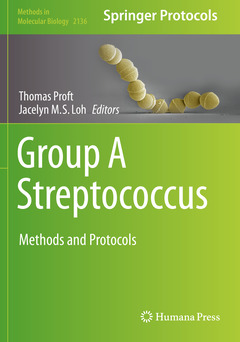Description
Group A Streptococcus, 1st ed. 2020
Methods and Protocols
Methods in Molecular Biology Series, Vol. 2136
Language: English
Subjects for Group A Streptococcus:
Keywords
PilVax; GcAVs; Phagocytosis assay; CRISPR-Cas; GAS biofilms; infectious diseases
Publication date: 05-2021
Support: Print on demand
Publication date: 05-2020
Support: Print on demand
Description
/li>Contents
/li>Comment
/li>
This volume details Group A Streptococcus (GAS) research and provides the reader with an extensive collection of research protocols within this important field. Chapters guide readers through standard genetic protocols such as whole genome sequencing, transcriptome analyses, proteome analysis, application of GAS-derived molecular tools, and methods that are crucial for the evaluation of novel GAS vaccines and GAS virulence factors, including bactericidal assays and animal infection models. Written in the highly successful Methods in Molecular Biology series format, chapters include introductions to their respective topics, lists of the necessary materials and reagents, step-by-step, readily reproducible laboratory protocols, and tips on troubleshooting and avoiding known pitfalls.
Authoritative and cutting-edge, Group A Streptococcus: Methods and Protocols aims to ensure successful results in the further study of this vital field.
Part I: Genotyping and Genetic Manipulation of Group A Streptococcus
1. Detection of Streptococcus pyogenes Virulence Factors
Aleksandra Kozińska and Izabela Sitkiewicz
2. Closed-Tube Multiplex Real-Time PCR for the Detection of Group A Streptococcal Superantigens
Nour Zahi Gammoh andLothar Rink
3. The emm-cluster Typing System
Pierre R. Smeesters and Anne Botteaux
4. Protocols for Tn-seq Analyses in The Group A Streptococcus
Yoann Le Breton, Ashton T. Belew, and Kevin S. McIver
5. Genetic Manipulation of Group A Streptococcus – Gene Deletion by Allelic Replacement
Timothy C. Barnett, Jessica N. Daw, Mark J. Walker, and Stephan Brouwer
6. Generation of Bioluminescent Group A Streptococcus for Biophotonic Imaging
Jacelyn M. S. Loh, Kar Yan Soh, and Thomas Proft
Part II: Application of Group A Streptococcus Omics
7. Whole Genome Sequence Analysis and Population Genomics of Group A streptococci
Jake A Lacey, Taylah B James, Steven YC Tong, and Mark R Davies
8. Group A Streptococcus Transcriptome Analysis
Misú Sansonand Anthony R. Flores
9. Protocol for Proteome Analysis of Group A Streptococcus
Laura Wilk
10. Investigation of Group A Streptococcal Interactions with Host Glycan Structures using High Throughput Techniques: Glycan Microarray Analysis using Recombinant Protein and Whole Cells
Anuk Indraratna, David De Oliveira, Lauren E Hartley –Tassell, Christopher J Day, Mark J Walker, Michael P Jennings, and Martina L Sanderson-Smith
Part III: Assays to Investigate Group A Streptococcus Virulence Factors And Virulence Mechanisms
11. Using Lactococcus lactis as Surrogate Organism to Study Group A Streptococcus Surface Proteins
Catherine (Jia-Yun) Tsai, Jacelyn M.S. Loh, Sam Blanchett, and Thomas Proft
12. Expression and Purification of Collagen-like Proteins of Group A Streptococcus
Slawomir Lukomski and Dudley H. McNitt
13. Detection of Fibronectin-binding Proteins of Streptococcus pyogenes using Ligand Blot Analysis
Masanobu Nakata and Shigetada Kawabata
14. Morphology and Ultrastructure of Group A Streptococcus Biofilms
Tatyana A. Danilova, T.A. Smirnova, G.A. Danilina, A.A. Adzhieva, N.V. Shevlyagina, and V.G. Zhukhovitsky
15. Dynamic Interactions of Group A Streptococcus with Host Macrophages
Angelica Riestra and J. Andrés Valderrama
16. Identification of Group A Streptococcus-containing autophagosome-like vacuoles
Takashi Nozawa and Ichiro Nakagawa
17. Flow Cytometry-based Assays to Quantify Complement Deposition and Neutrophil Uptake of Group a Streptococcus
Nicola N.Lynskey
18. Live Cell Microscopy and Flow Cytometry to study Streptolysin S Mediated Erythrocyte Hemolysis
Dustin L. Higashi, Charles R. Tessier, and Shaun W. Lee
19. Isolation of Monoclonal Antibodies to Group A Streptococcus Antigens Using Phage Display
Jeremy M. Raynes, Mei Lin Tay, Sok H. By, John D. Steemson, and Nicole J. Moreland
Part IV: Group A Streptococcus Killing Assays and Infection Models
20. Assays to Analyse Adhesion of Group A Streptococcus to Host Cells
Adrina H. J. Khemlani, Thomas Proft, and Jacelyn M.S. Loh
21. The use of Galleria mellonella (wax moth) as an Infection Model for Group A Streptococcus
Catherine (Jia-Yun) Tsai, Jacelyn M.S. Loh, and Thomas Proft
22. A Superficial Skin Scarification Method in Mice to Mimic Streptococcus pyogenes Skin Infection in Humans
Manisha Pandey and Michael F Good
23. A Mouse Nasopharyngeal Colonisation Model for Group A Streptococcus
Adrina H. J. Khemlani, Thomas Proft, and Jacelyn M. S. Loh
24. Humanised Plasminogen Mouse Model to Study Group A Streptococcus Invasive Disease
Tania Rivera-Hernandez and Mark J. Walker
25. Lacefield Whole Blood Killing Assay to Evaluate Vaccine Efficacy
Mark Reglinski
26. An Opsonophagocytic Killing Assay for the Evaluation of Group A Streptococcus Vaccine Antisera
Reuben McGregor , Scott Jones , Jeremy Raynes , David Goldblatt , and Nicole J. Moreland
Part V: Group A Streptococcus Therapies
27. Validation of Suitable Carrier Molecules and Target Genes for antisense Therapy using Peptide-coupled Peptide Nucleic Acids (PNAs) in Streptococci
Gina Barkowsky, Bernd Kreikemeyer, and Nadja Patenge
28. Interfering with the Folding of Group A Streptococcal pili Proteins
Fernanda Contreras and Jaime Andrés Rivas-Pardo
Part VI: Application of Group A Streptococcus-derived Methods
29. Use of Streptolysin O (SLO) to Study the Function of Lipid Rafts
Heather E. Miller
30. Engineering of Group A Streptococcus Isopeptide Bonds into Immunoglobulin-like Protein Domains
Paul G. Youngand Edward N. Baker
Includes cutting-edge methods and protocols
Provides step-by-step detail essential for reproducible results
Contains key notes and implementation advice from the experts




